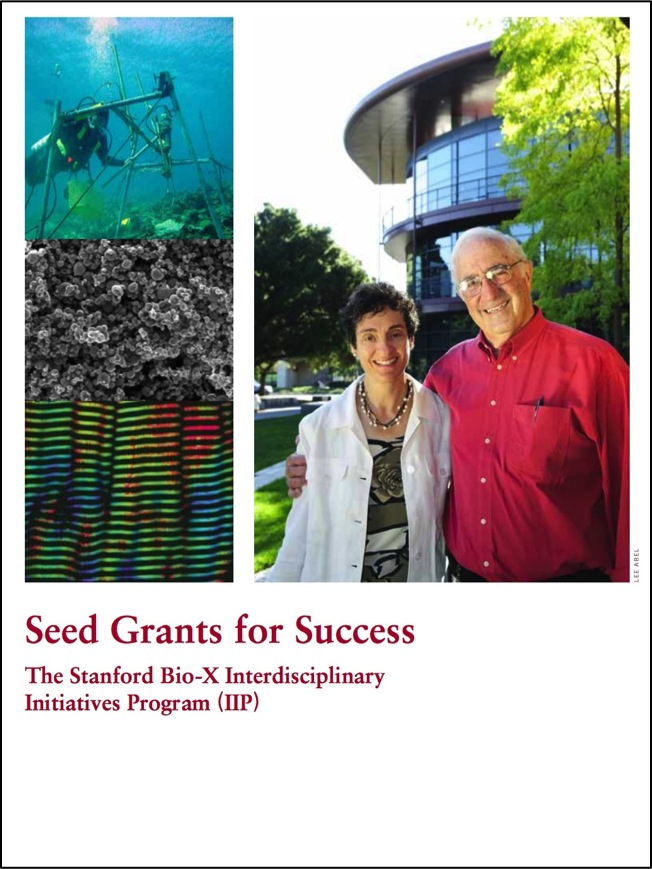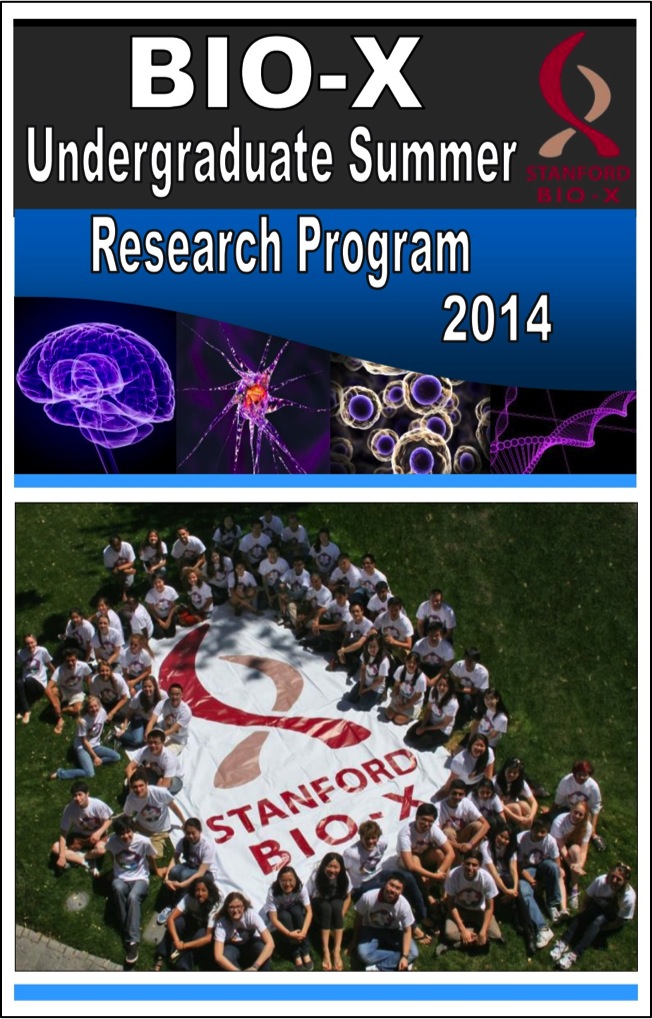
Welcome to the biweekly electronic newsletter from Stanford Bio-X for members of the Bio-X Corporate Forum. Please contact Dr. Hanwei Li, the Bio-X Corporate Forum Liaison if you would like to be added or removed from this distribution list, or if you have any questions about Stanford Bio-X or Stanford University.
Highlights
** On October 9, 2013, Bio-X celebrated the 10th Anniversary of the James H. Clark Center, the hub of Bio-X. Check out CLARK CENTER @ 10X as well as the Bio-X Timeline over the last 15 years!!
** Check out the article by Stanford President John Hennessy in the Nov/Dec 2013 issue of the Stanford Magazine on Bio-X and the Clark Center, "A Cauldron of Innovation".
Bio-X Core Programs
 SEED GRANTS FOR SUCCESS - Stanford Bio-X Interdisciplinary Initiatives Program (IIP) SEED GRANTS FOR SUCCESS - Stanford Bio-X Interdisciplinary Initiatives Program (IIP)The Bio-X Interdisciplinary Initiatives Program represents a key Stanford Initiative to address challenges in human health. Currently, the IIP awards approximately $4 million every other year in the form of two-year grants averaging about $200,000 each. From its inception in 2000 through the beginning of the seventh round in 2014, the program has provided critical early-stage funding to 164 different interdisciplinary projects, involving collaborations from over 750 faculty members, and creating over 700 teams from six different Stanford schools. From just the first 6 rounds, the IIP awards have resulted in a 10-fold-plus return on investment, as well as hundreds of publications, dozens of patents filed, and most importantly, the acceleration of scientific discovery and innovation. 2014 is the start of the 7th round of the Bio-X IIP Seed Grants Program, and 22 newly awarded projects were selected from 142 Letters of Intent (LOIs)! This has been the largest number of LOIs that Bio-X has received. Please go here to check out the newly awarded projects. Competition was intense, and the selection criteria included innovation, high-reward, and new interdisciplinary collaborations. (To view the 142 other IIP projects that have been funded from the previous 6 rounds, please click here.) |
 Bio-X FELLOWSHIPS Bio-X FELLOWSHIPSEvery year, graduate students and postdoctoral scholars of Bio-X affiliated faculty are highly encouraged to apply for the Bio-X Fellowships, which are awarded to research projects that are interdisciplinary and utilize the technologies of different fields to solve different biological questions. Students are encouraged to work collaboratively with professors of different departments, thus creating cross-disciplinary relationships among the different Stanford schools. Our fellows have conducted exciting research, resulting in publications in high-impact journals and have been offered excellent positions in industry and academia. To date, with the 19 new awardees of 2014, Stanford Bio-X has a total of 173 Fellows. The call for 2015's PhD Fellowship program has just begun! You can view the numerous Fellowship projects that have been awarded over the years as well as oral presentations from previous symposiums here. |
 Bio-X UNDERGRADUATE SUMMER RESEARCH PROGRAM Bio-X UNDERGRADUATE SUMMER RESEARCH PROGRAMThe Bio-X Undergraduate Summer Research Program supports undergraduate research training through an award designed to support interdisciplinary undergraduate summer research projects. The program is an invaluable opportunity for students to conduct hands-on research, learn how to carry out experiments in the laboratory, and develop the skills to read and analyze scientific literature. This program is eligible to Stanford students who want to work in the labs of Bio-X affiliated faculty. To date, with 65 new awardees from 154 applications submitted this year, 306 students have been awarded the opportunity to participate in the Bio-X Undergraduate Summer Research Program. The call for 2015's USRP has just begun! Participating undergraduates are also required to present poster presentations on the research that they've conducted during the program. Please click here for title lists of past posters that our undergraduates have presented. |
We are cultivating and are highly successful in building meaningful collaborations with numerous corporate colleagues. New collaborations through our core programs are highly encouraged. To learn about how to get involved, please contact Dr. Hanwei Li, or Dr. Heideh Fattaey.
Bio-X also holds symposiums every year that highlight our core programs. The latest one was on February 25, 2015, where over 300 people attended Bio-X's latest Interdisciplinary Initiatives Seed Grants Program Symposium. There were 8 different oral presentations from faculty members who were awarded Bio-X Seed Grants on the progress that they have made with the funding towards their projects, as well as a packed poster session with 100+ research projects presented. Please stay tuned for future Bio-X symposiums that are coming up this year!
If you'd like to learn more about any of the projects that were presented during the entire symposium, please contact Dr. Hanwei Li with your questions.
News
 DNA ‘barcodes’ help researchers track rise, fall of yeast dynasties
DNA ‘barcodes’ help researchers track rise, fall of yeast dynasties
Bio-X Affiliated Faculty Gavin Sherlock
Bio-X IIP Seed Grant Project from Round 6 (with Bio-X Affiliated Faculty Daniel Fisher)
Bakers and beer brewers welcome the gentle, gradual bubbling that occurs when yeast is stirred into warm, sugary liquid. However, this soothing sign that all is well in the kitchen or brewery belies a pitched battle waged just under the murky surface. There, individual yeast “families,” or clones, compete for ever-more-scarce resources as their numbers grow. Those that develop mutations that give them an edge over the competition can go on to generate more progeny than their peers, effectively crowding them out altogether. This means little to those of us who simply want a fresh loaf of bread or a tasty lager. But understanding how this type of clonal competition and evolution plays out on a large scale could have important implications for researchers and clinicians trying to understand how a bacterium or virus spreads and changes during an infection, or how cancer cells evolve as a tumor grows or even rebounds from cancer treatment. Now, researchers at Stanford University have devised a way to label and track the descendants of about 500,000 individual yeast cells for hundreds of generations. The technique allowed the researchers to track the rise and fall of specific families over time in the teeming underworld of yeast-population dynamics.
 Small molecule might help reduce cancer in at-risk population, study finds
Small molecule might help reduce cancer in at-risk population, study finds
Bio-X Affiliated Faculty Daria Mochly-Rosen
Researchers at the Stanford University School of Medicine have found that by changing the selectivity of an enzyme, a small molecule could potentially be used to decrease the likelihood of alcohol-related cancers in an at-risk population. Enzymes are enablers. They are highly specialized parts of cellular machinery tasked with bringing together molecules to make it easier for chemical reactions to happen. Sometimes enzymes are defective and malfunction, which can cause disease. In a study of mice, the researchers discovered a creative way to circumvent the problems caused by a defective enzyme. They used a small molecule to "hijack," or change the function of, another enzyme so that it mimicked and compensated for the function of the broken enzyme. "We found a molecule that can steer an enzyme to perform a new function," said Daria Mochly-Rosen, PhD, professor of chemical and systems biology, who is the senior author of a paper about the study. Che-Hong Chen, PhD, a senior research scientist, is lead author of the paper, which was published online Feb. 23 in the Proceedings of the National Academy of Sciences. Specifically, the researchers found that a small molecule could convert a particular enzyme from being ineffective at metabolizing alcohol-derived acetaldehyde to being very effective at the process. Although this molecule, Alda-89, is not suitable for use in humans because of its toxicity, enzyme hijacking is a promising new route for drug discovery, the researchers said. Finding other, safer molecules that can hijack enzymes could help prevent certain human cancers and is the current focus of the Mochly-Rosen laboratory.


Skin tumors develop specific mutations to resist drug, researchers say
Bio-X Affiliated Faculty Anthony Oro
Bio-X Affiliated Faculty Jean Tang
Dermatology Faculty Anne Chang
Among people with advanced basal cell carcinomas who see their skin cancers shrink or disappear in response to a common drug therapy, about 20 percent will relapse within months as the cancer cells become resistant to the treatment. The situation is frustrating to both patients and their physicians. Now, researchers at the Stanford University School of Medicine have identified specific mutations in the cancer cells that confer resistance to the drug, vismodegib, which is sold under the brand name Erivedge. They’ve also shown that another class of drug, called a Gli antagonist, may be able to successfully tackle even vismodegib-resistant cancers. The finding could hasten the use of Gli antagonists in the clinic, they said. “This research sheds new light on mechanisms of how tumors evolve to develop drug resistance, and has already helped us with personalized cancer genetics and therapy for our patients,” said Anthony Oro, MD, PhD, professor of dermatology. “It is now possible for us to identify those people who may benefit from a combination therapy even before they begin treatment.” A paper describing the research findings was published March 9 in Cancer Cell. Oro; Jean Tang, MD, PhD, associate professor of dermatology; and Anne Chang, MD, assistant professor of dermatology, share senior authorship.
Events
| Genetics Mar 11, 2015, 4 pm - 5 pm Clark Center Auditorium, Stanford, CA Frontiers in Biology - "Tumor suppression and maintenance genes" Speaker: Scott Lowe, PhD, Sloan-Kettering |
Cardiovascular Institute Mar 17, 2015, 12 pm - 1 pm Li Ka Shing Center, Paul Berg Hall A, Stanford, CA Frontiers in Cardiovascular Science - "Systems Pathobiology and Network Medicine in Cardiovascular Disease" Speaker: Joseph Loscalzo, MD, PhD, Editor, Circulation |
Resources
| Stanford University |
| Stanford Bio-X |
| Bio-X Seed Grants The Stanford Bio-X Interdisciplinary Initiatives Program (IIP) provides seed funding for high-risk, high-reward, collaborative projects across the university, and have been highly successful in fostering transformative research. |
| Office of Technology and Licensing "Techfinder" Search the OTL Technology Portal to find technologies available for licensing from Stanford. |
| Stanford Center for Professional Development - Take advantage of your FREE membership! - Take online graduate courses in engineering, leadership and management, bioscience, and more. - Register for free webinars and seminars, and gets discounts on courses. |
| Stanford Biodesign Video Tutorials on how FDA approves medical devices A series of video briefs recently produced by the Stanford Biodesign Program teaches innovators how to get a medical device approved for use in the United States. This free, online library of 60 videos provides detailed information on the Food and Drug Administration regulatory process, short case studies and advice on interacting with the FDA. |
To learn more about Stanford Bio-X or Stanford University, please contact Dr. Hanwei Li, the Bio-X Corporate Forum Liaison, at 650-725-1523 or lhanwei1@stanford.edu, or Dr. Heideh Fattaey, the Executive Director of Bio-X Operations and Programs, at 650-799-1608 or hfattaey@stanford.edu.

